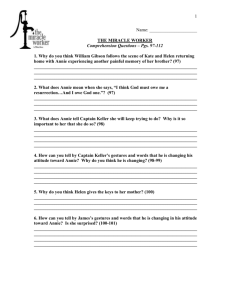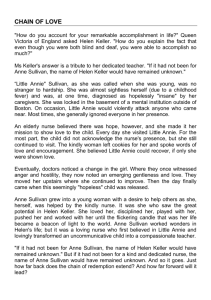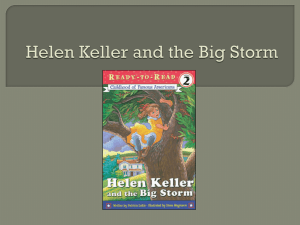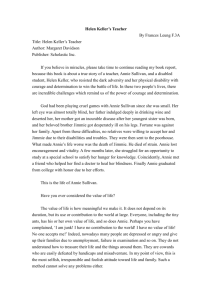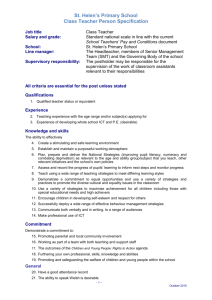Biography of Helen Keller
advertisement
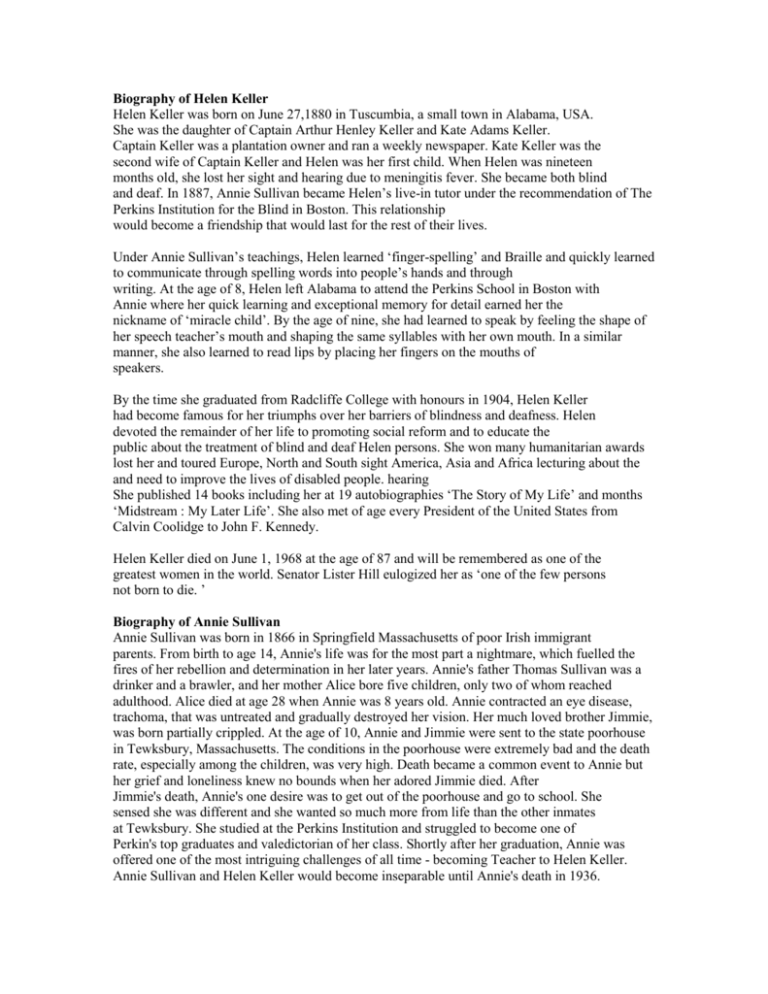
Biography of Helen Keller Helen Keller was born on June 27,1880 in Tuscumbia, a small town in Alabama, USA. She was the daughter of Captain Arthur Henley Keller and Kate Adams Keller. Captain Keller was a plantation owner and ran a weekly newspaper. Kate Keller was the second wife of Captain Keller and Helen was her first child. When Helen was nineteen months old, she lost her sight and hearing due to meningitis fever. She became both blind and deaf. In 1887, Annie Sullivan became Helen’s live-in tutor under the recommendation of The Perkins Institution for the Blind in Boston. This relationship would become a friendship that would last for the rest of their lives. Under Annie Sullivan’s teachings, Helen learned ‘finger-spelling’ and Braille and quickly learned to communicate through spelling words into people’s hands and through writing. At the age of 8, Helen left Alabama to attend the Perkins School in Boston with Annie where her quick learning and exceptional memory for detail earned her the nickname of ‘miracle child’. By the age of nine, she had learned to speak by feeling the shape of her speech teacher’s mouth and shaping the same syllables with her own mouth. In a similar manner, she also learned to read lips by placing her fingers on the mouths of speakers. By the time she graduated from Radcliffe College with honours in 1904, Helen Keller had become famous for her triumphs over her barriers of blindness and deafness. Helen devoted the remainder of her life to promoting social reform and to educate the public about the treatment of blind and deaf Helen persons. She won many humanitarian awards lost her and toured Europe, North and South sight America, Asia and Africa lecturing about the and need to improve the lives of disabled people. hearing She published 14 books including her at 19 autobiographies ‘The Story of My Life’ and months ‘Midstream : My Later Life’. She also met of age every President of the United States from Calvin Coolidge to John F. Kennedy. Helen Keller died on June 1, 1968 at the age of 87 and will be remembered as one of the greatest women in the world. Senator Lister Hill eulogized her as ‘one of the few persons not born to die. ’ Biography of Annie Sullivan Annie Sullivan was born in 1866 in Springfield Massachusetts of poor Irish immigrant parents. From birth to age 14, Annie's life was for the most part a nightmare, which fuelled the fires of her rebellion and determination in her later years. Annie's father Thomas Sullivan was a drinker and a brawler, and her mother Alice bore five children, only two of whom reached adulthood. Alice died at age 28 when Annie was 8 years old. Annie contracted an eye disease, trachoma, that was untreated and gradually destroyed her vision. Her much loved brother Jimmie, was born partially crippled. At the age of 10, Annie and Jimmie were sent to the state poorhouse in Tewksbury, Massachusetts. The conditions in the poorhouse were extremely bad and the death rate, especially among the children, was very high. Death became a common event to Annie but her grief and loneliness knew no bounds when her adored Jimmie died. After Jimmie's death, Annie's one desire was to get out of the poorhouse and go to school. She sensed she was different and she wanted so much more from life than the other inmates at Tewksbury. She studied at the Perkins Institution and struggled to become one of Perkin's top graduates and valedictorian of her class. Shortly after her graduation, Annie was offered one of the most intriguing challenges of all time - becoming Teacher to Helen Keller. Annie Sullivan and Helen Keller would become inseparable until Annie's death in 1936. Helen’s World —Birth to Age 20 Year 1880-1900 –Science, Culture, & Events • Edison invents the light bulb · The first wire photos • The linotype is invented • The first Kodak box cameras are produced • Photo printing processes are developed • Internal combustion engine developed • Radio-telegraph invented by Marconi • Punch-card used to collect census data • Adding machines invented · The X-Ray is invented • George Washington Carver performs agricultural research on the use of the peanut • Rodin sculps “The Thinker” · Tolstoy is born • Quaker Oats is a new breakfast food • The Eiffel Tower is designed • The first daily newspapers appear in major cities • Sherlock Holmes stories are written • Tchaikovsky’s “Nutcracker” is first performed • First US motion picture studio built • H.G Wells writes “The Time Machine” • Daily mail delivery becomes possible in the US, Canada, England • James Garfield elected US president 1880 • Czar Alexander II killed • Greenwich Mean Time adopted · Coca-Cola is invented • Jack the Ripper terrorized London • 250,000 telephones exist in the world • Typewriters become common in offices • The first Hershey’s chocolate bar • Wilfred Laurier is elected Prime Minister in Canada Biography of playwright William Gibson William Gibson was born in 1914 in New York City where he spent most of his childhood. Gibson enjoyed success in his early academic years earning him the privilege of skipping grades. He showed promise as a writer being an avid reader and winning several awards for his writing in high school. Despite his success in literature, Gibson struggled in subjects such as math, science and history. Gibson was also a talented piano player and often performed popular duets with his father at community gatherings. Gibson attended City College in New York City, but became frustrated after enrolling in a science program under the bad advice of a professor. He decided to pursue his love of writing as a result of the encouragement of his literature professor and his expulsion from college for not completing any other courses. It would be 20 years before Gibson made a living in his chosen profession, and was supported until then by his wife and odd parttime jobs. His most popular plays are The Miracle Worker and Two for the Seesaw. In 1982, Gibson wrote a sequel to The Miracle Worker entitled Monday after the Miracle based on the life of Helen Keller as a college student. Gibson now lives in Stockbridge, Massachusetts, where he co-founded the Berkshire Theatre Festival.
